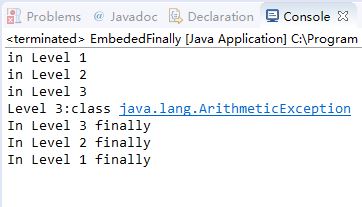1.阅读以下代码CatchWho.java,CatchWho2.java,写出程序运行的结果;阅读 EmbedFinally.java示例,再运行它,观察其输出并进行总结。
CatchWho.java示例代码:
package ExceptSourceCode07; public class CatchWho { public static void main(String[] args) { try { try { throw new ArrayIndexOutOfBoundsException(); } catch(ArrayIndexOutOfBoundsException e) { System.out.println( "ArrayIndexOutOfBoundsException" + "/内层try-catch"); } throw new ArithmeticException(); } catch(ArithmeticException e) { System.out.println("发生ArithmeticException"); } catch(ArrayIndexOutOfBoundsException e) { System.out.println( "ArrayIndexOutOfBoundsException" + "/外层try-catch"); } } }
输出结果截图:

CatchWho2.java示例代码:
package ExceptSourceCode07; public class CatchWho2 { public static void main(String[] args) { try { try { throw new ArrayIndexOutOfBoundsException(); } catch(ArithmeticException e) { System.out.println( "ArrayIndexOutOfBoundsException" + "/内层try-catch"); } /*finally { System.out.println("没捕捉到的内层finally也执行啦!!!"); } */ throw new ArithmeticException(); } catch(ArithmeticException e) { System.out.println("发生ArithmeticException"); } catch(ArrayIndexOutOfBoundsException e) { System.out.println( "ArrayIndexOutOfBoundsException" + "/外层try-catch"); } } }
输出结果截图:

EmbedFinally.java示例代码:
package ExceptSourceCode07; public class EmbededFinally { public static void main(String args[]) { int result; try { System.out.println("in Level 1"); try { System.out.println("in Level 2"); // result=100/0; //Level 2 try { System.out.println("in Level 3"); result=100/0; //Level 3 } catch (Exception e) { System.out.println("Level 3:" + e.getClass().toString()); } finally { System.out.println("In Level 3 finally"); } // result=100/0; //Level 2 } catch (Exception e) { System.out.println("Level 2:" + e.getClass().toString()); } finally { System.out.println("In Level 2 finally"); } // result = 100 / 0; //level 1 } catch (Exception e) { System.out.println("Level 1:" + e.getClass().toString()); } finally { System.out.println("In Level 1 finally"); } } }
输出结果截图:

总结:
1.当两层try-catch-finally嵌套时,异常在内层抛出在内层被捕获后,外嵌套其的外层try如果还有其他语句还会继续执行;但是如果内层抛出的异常没有被捕获,则嵌套其的外层try不会继续执行,因为内层try抛出异常,内层又没有捕获异常的语句,则从外层try向外层继续抛出异常,而不会继续执行外层try语句。
2当多层try-catch-finally嵌套时,异常在不同的层次抛出,在不同的位置抛出,异常就会在不同层次被捕获,同时可能会导致不同的finally语句块执行顺序。
2.辨析:finally语句块一定会执行吗?请通过 SystemExitAndFinally.java示例程序回答上述问题。
SystemExitAndFinally.java示例代码:
package ExceptSourceCode07; public class SystemExitAndFinally { public static void main(String[] args) { try{ System.out.println("in main"); throw new Exception("Exception is thrown in main"); //System.exit(0); } catch(Exception e) { System.out.println(e.getMessage()); System.exit(0); } finally { System.out.println("in finally"); } } }
输出结果截图:

总结:
不一定,当try-catch中含有System.exit(0)语句时,程序退出jvm了,不再执行finally语句。
3.依据对本讲多个示例程序的分析,请自行归纳总结出Java多层嵌套异常处理的基本流程。
Java多层嵌套异常处理的基本流程总结:
1.try语句嵌套从外层到内层执行,在try语句中,哪一层出错,哪一层就抛出异常,该层后边的try语句就不再执行,如果该层存在catch就进行相应的捕获,且内层try中嵌套的try-catch语句外部如果还有语句会继续执行;如果该层没有catch进行捕获,就向外抛出,如果外部try-catch语句中也没有catch进行捕获,就终止程序。
2.try-catch-finally语句嵌套时,内层try抛出异常,即使catch没有捕捉到抛出的异常,内层的finally也一样会执行,然后异常继续向外抛出,除非遇到极特殊的System.exit(0)在finally语句之前的try-catch中,finally语句才不执行。
4.编写一个程序,此程序在运行时要求用户输入一个 整数,代表某门课的考试成绩,程序接着给出“不及格”、“及格”、“中”、“良”、“优”的结论。要求程序必须具备足够的健壮性,不管用户输入什么样的内容,都不会崩溃。
设计程序代码如下:
//信1605-2 20160955 张晨阳 package homework5; import java.util.Scanner; public class ExamGradeRank { public static void main(String[] args) { try { System.out.println("请输入张三的java成绩(取整数部分):"); Scanner input=new Scanner(System.in); int grade; int flag=1; while(flag!=0) { grade=Integer.parseInt(input.next()); if(grade>=0&&grade<=100) { if(grade<60) { System.out.println("不及格"); } else if(grade<70) { System.out.println("及格"); } else if(grade<80) { System.out.println("中"); } else { System.out.println("优"); } flag=0; } else { System.out.println("输入成绩的范围不在0~100之间,请重新输入:"); } } } catch(NumberFormatException e) { System.out.println("输入的数据类型有误,输入必须是整数!"); } catch(Exception e) { System.out.println("程序出现了其他异常!"); } } }
运行结果截图:
